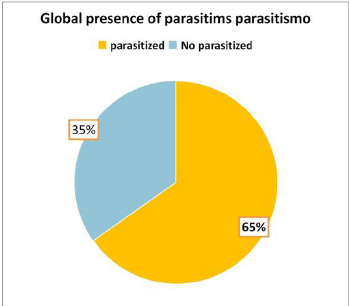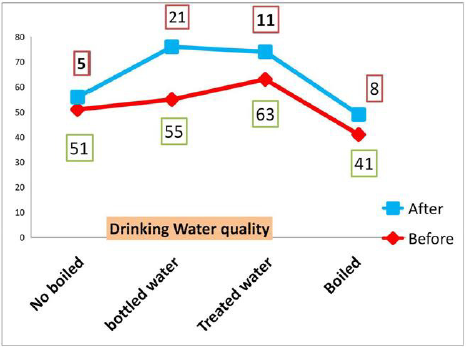Impact of a Model of Educational Intervention on Intestinal Parasitism in Children of Havana. 2021 Second Post-Evaluation and Intervention Study
Introduction
Among infectious diseases, those produced by parasites
constitute important health problems for man and at the present
time they are a medico-social problem that affects not only the
so-called Third World countries, but also those with the highest
development. In studies carried out in children from suburban
regions of the American continent, at least seven parasites
predominate: ascariasis, whipworm, oxyuriosis, amebiosis,
hookworms, giardiasis and strongyloidosis [1]. Intestinal parasitism
affects all people equally, however, due to their characteristics, the
child population has a high level of susceptibility to suffer them,
since there is a greater opportunity of contact with these parasites
because they spend a large part of the day in schools and carry
out activities collectively, which can favor the conditions for the
transmission of some parasitic diseases, especially those in which
their main transmission mechanism is the oral fecal route, in
addition to presenting a lower immunological level [1-2] From a
global perspective, intestinal parasitism is a major health problem
in underdeveloped countries where it causes significant morbidity
and mortality. Thus, the mortality caused by the three most frequent
intestinal parasitic infections in the world is not negligible: 60,000
deaths a year from ascarislumbricoides, 65,000 deaths a year from
hookworms and necatoramericanus, and 10,000 deaths a year from
trichuristrichiura [3].
Symptomatic intestinal parasites can cause some morbidity and mortality, but this is not very significant. However, it represents a risk for groups with poor hygiene, such as nurseries or institutions for the mentally handicapped, or for patients with primary or secondary immunosuppression, in whom the infection can be severe. In addition to immunosuppression, various sociological phenomena make the topic of intestinal parasitism of current interest to the pediatrician. The most important are emigration and the adoption of children from third world countries, but also the phenomenon of globalization, with constant mobility of large masses of the population and frequent trips to underdeveloped countries for tourism or work reasons that expose the indigenous population. to the contagion of endemic parasites in certain areas. The orientation of the problem in these cases must be done taking into account not only the symptoms but also the origin of the population or the place of displacement since certain pathogens will predominate over another [4].
Intestinal parasitic infections by helminths and protozoa are among the most common in man in Latin America [5]. These have been consistently and considerably estimated in their impact on public health; However, in the last decade, its recognition as an important public health problem has increased even more [6]. In Venezuela, various studies indicate variable prevalences, but most of them have been carried out in urban populations. There is great morbidity, among protozoa, especially blastocystis hominis and entamoeba coli, and among helminths, ascaris lumbricoides [3- 4]. Intestinal parasitism represents an alarming health problem in Venezuela due to the large number of people affected and the intense organic disturbances that they can cause. Many times it corresponds to the only morbid process of the patient and sometimes they aggravate other concomitant diseases Due to the aforementioned and taking into account that the mission of the doctor is the promotion and prevention of health, it was decided to carry out an educational intervention study in children of primary education of the Municipality of Marianao Province of Havana , in order to determine the influence of this work on hygienic practices and the prevalence of intestinal parasitism in students, identify the associated symptoms, as well as compare the hygienic practices of the population before and after the educational work.
Materials & Methods
An intervention study was carried out in order to determine the influence of educational work on hygienic practices and the prevalence of intestinal parasitism in students from preschool to sixth grade. 210 children were studied, five for each grade of the six primary schools enrolled in said institution. These schools have already been previously evaluated and intervened, for which the results meter will help us to see the impact of the intervention carried out. The homes were visited to explain the objective of the study to the parents or guardians of the children, their informed consent was collected and a survey was applied to them. The symptoms and clinical signs presented in the children were analyzed, to describe the health education of the family, the quality of the drinking water, the washing of hands before eating food and after defecation, the presence of vectors, the presence of vectors, was taken into account. washing fruits and vegetables, if they are used to walking barefoot, playing with dirt or biting their nails.
Then a stool sample was taken by spontaneous defecation, guiding the parents about the need for non-contamination of it. Each child was given a sterile vial containing 7% formaldehyde solution. The fecal samples were processed in the Microbiology Department of their Polyclinic, where they were subjected to direct examination with Lugol’s solution with 1% eosin and a concentrated examination by the Willis method for enrichment of helminth eggs. A sample was taken from each child in the morning, without previous cleaning, for the diagnosis of Enterobius vermicularis (pinworm) by the Graham method. The clinical evaluation of the parasitized children was carried out, the laboratory results were analyzed and appropriate treatment was applied.
Parasitized Children Received Treatment According to International Standards
The information collected made it possible to identify learning needs and changes in attitudes, for which a study program was designed. They were formed five groups of 20 people each, structuring activities in three sessions of one hour each, with a weekly frequency for each group and develop throughout the month of November 2019. Six months after the educational intervention, the second sample collection and the second application of the survey were indicated, with characteristics similar to the previous one. The percentage was used as a measure for each variable. The research results were presented to summarize the information in tables. The information collected was processed and stored on a Pentium 4 microprocessor, using the Microsoft Office 2003 data processing programs contained in the Windows XP Professional operating system.
Results
The prevalence of intestinal parasitism (Graph 1) was observed that out of a total of 210 schoolchildren, 137 children were parasitized for 65.2 % and only 73 were not parasitized for 34.8 %, so it can be considered that in schoolchildren studied there is a high prevalence of parasites. Parasitic agents in school (Table 1) were more frequently Enterobius vermicularis in 65 children for a 4 7.4 %, and Giardia lamblia and E. Histology and tica 34 and 23 school for a 2 4/8 and 16, 8 % respectively. After the intervention was applied, all the parasitic agents decreased. The most frequent symptoms presented by parasitized children (Table 2) before and after the intervention were anal itching in 44 students, sleep disorders with 31 and irritability in 27 for 32.1%, 22.6% and 9.7%, respectively. After the intervention, the frequency in each of them decreased, although it is worth clarifying that there are symptoms that appear as part of the child’s physiology at school. In the hygienic practices of the population before and after the educational intervention (Table 3), an inadequate hygiene of the population was observed before the intervention, after which all the hygienic habits of the population were positively modified (Table 4). The epidemiological factors present in the home of the schoolchildren were the most prevalent Do not wash foods consumed raw with 28.1% and the consumption of non-potable water with 51%, after the intervention all modifiable epidemiological risks decreased In the variable quality of drinking water (Graph 2) it was shown that 51% of the patients did not boil their drinking water, 63% of them treated the water, with the bottled water trade and the myths that it contains 55% of those who consumed this water were shown to be parasitized After the educational work, those who consumed the water without boiling decreased to 8%, while those who boiled or chlorinated it represented 5% and 11% respectively.
Figure 1: Prevalence of intestinal parasitism in primary school children.
Note: Source: parasitologicalstudy.
Figure 2:Water consumption in the homes of schoolchildren before and after the educational intervention.
Note: Source: sociodemographicregistry.
Note: 137 Source: primary registry and parasitological study
Table 2: Most frequent symptoms in parasitized children before and after the educational intervention.
Note: N:137 Source: sociodemographicregistry.
Note: N: 210 Source: primarysurvey.
Table 4: Epidemiological factors present in the homes of the schoolchildren before and after the intervention.
Note: Source: sociodemographicsurvey.
Discussion
The Enterobius vermicularis causes the disease called Enterobiasis or pinworm, with a worldwide spread, because this parasite does not require favorable environmental conditions, since the transmission is direct from person to person, without the need for intervention from the floor. This parasitosis occurs in individuals of all ages, but is higher in school age. In a study carried out by Díaz and collaborators, in students of Basic Education of the Municipality of Cacique Mara, in the state of Zulia in Venezuela, a 45.9% prevalence of helminthiasis was demonstrated with a predominance of oxyuriasis, these results coinciding with those of the present investigation. Devera et al., Reported a prevalence for enterobiasis of 48.8%, well above the other parasitosis, results similar to the present study [4-7]. The authors refer that oxyuriosis becomes frequent because the eggs are highly infective from the moment the adult female parasite lays them on the margins of the anus, and there may be self-reinfection by the hands or indirectly by contaminated items such as furniture, desks, bathrooms, or by inhalation of dust in homes and institutions [8-9]. In this study, the most frequent symptoms were (after anal itching and irritability) abdominal pain and loss of appetite, related to enterobiasis or ascariasis, a parasite that was identified in the first and second order in the study. In a study carried out by Kucik and collaborators, they state that among the most frequent symptoms caused by enterobiousvermicularis were irritability and anal itching; while ascarislumbricoides is more associated with diarrhea, abdominal pain, decreased appetite, and weight loss, and trichuristrichiura is associated with anemia, decreased appetite, and weight loss [10- 12].
After the educational intervention was carried out, intestinal parasitism was significantly reduced and hygienic practices increased, indicating that inadequate hygienic practices influenced the presence of parasitism, similar conclusions reported by Medina and González in their study Intestinal Parasitism in Spain [12-15] As it is a comparison of the same subject before and after, it can be affirmed that the educational work together with the treatment helped the success of the group work. Hernández, Rauda and collaborators in a study carried out in San Salvador, on the socioepidemiological factors related to the specific prevalence of intestinal parasitic infections caused by protozoa and helminths in children under 14 years of age from the Atonatl community, metropolitan area of San Salvador, pointed out that the lack of habit of applying chemical or thermal treatment to water, prior to consumption, was significantly related to the parasitism found in children, which coincides with the results of the present work .
Conclusion
The prevalence of intestinal parasites in school children
studied was elevated preoperatively, predomin or the Enterobius
vermicularis. An obvious decrease in the prevalence of parasitism
was evidenced after the educational intervention carried out. The
most frequent symptoms in parasitized children were anal itching,
irritability, abdominal pain and loss of appetite, which decreased
after the intervention. The educational intervention applied was
effective, since hygiene practices such as washing hands before
eating food or after defecating, walking barefoot, playing with
dirt, biting nails and not boiling drinking water, were significantly
modified.
For more Articles on : https://biomedres01.blogspot.com/








No comments:
Post a Comment
Note: Only a member of this blog may post a comment.